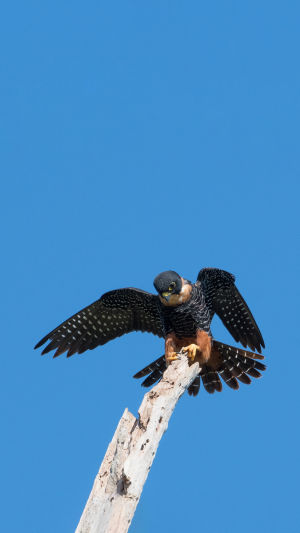There are many species of eagle, with an estimated 190 species worldwide. Basically all hawks can be domesticated for falconry.
Some of the better eagle species are the golden eagle and the peregrine falcon.
Golden eagles are rarer. In the food chain, falconry is the collective name for animals in the genus Falconidae, the falcons.
There are more species, but they are all fierce predators that are very strong fliers and feed mainly on birds, rats and other small animals, etc.
Falconry is a highly cultural and traditional activity in the Middle East, rich in Arabian history and an important part of desert life.
The UAE is home to Arabian falconry and the culture is a national symbol of the country.
The golden falcon on the UAE coat of arms shows the great importance the country places on this tradition.
Long used by the Bedouin as a hunting tool in the desert, the falcon's catch adds to the meat diet of the desert nomads.
Specialising in hunting hares and bobtail bustards, the falcon is a notoriously fast creature, reaching 300km/h in pursuit of its prey.
Today, falconry has developed into a national sport in the UAE, playing an important social and economic role in the country's history and becoming a hobby for young people.
Many people enjoy spending time with their falcons, training them and developing a strong bond with them. Friends would meet regularly to chat and exchange ideas on how best to care for these raptors.
Fathers will teach their sons the sport, which not only helps them learn to enjoy the desert, but also helps instil qualities like self-discipline and patience.
In 2012, UNESCO inscribed falconry as an intangible cultural heritage of humanity.
The first step in taming a newly caught wild falcon, which is extremely violent and restless, fearful and may attack on its own initiative, is to first tame its wild nature (boil the falcon) by putting a hood made of leather over its head and covering its eyes so that it loses its eyesight.
At this time, the hawk is fed once a day with fresh meat soaked in water and brought to its mouth by hand, with only 1/2 of the original amount of food to keep it hungry.
The falcon can also be taken to a busy street on an arm or perch and, as the handler moves and shakes his arm.
The falcon is touched with his hand on all parts of its body, including its head and beak shell, to encourage it to get closer to the handler.
The falcon may be made to approach the handler at night. At night they can be made to stand on the shelf.
After the falcon's wildness has gradually diminished, the handler will make a sound as a feeding signal when feeding, so that when it hears the sound, it will have the conditioned reflex to feed.
Later on, the falcon will be lured and trained to catch the prey with the sound of the feeding signal and given a small amount of prey to feed on after successful hunting, which will be more conducive to the next hunt.
In short, falcons should not be fed enough to make them slightly hungry.
they should not be too fat, as fat falcons are often reluctant to chase prey and often escape.
However, an overly lean and hungry falcon is not as strong as it should be and is not conducive to the rapid pursuit of prey.
The daily diet for falcons is based on fresh beef and lamb, which should be soaked in warm water before feeding to increase moisture and temperature for good health. It is also good for health to feed appropriate prey.
The exact amount of food should be flexible. Domesticated falcons require regular training to catch prey and are not suitable for courtship and breeding.
A tame falcon will be worth hundreds or even thousands of times more.





